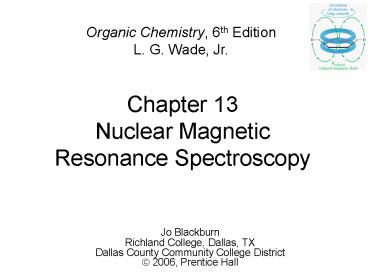Chapter 13 Nuclear Magnetic Resonance Spectroscopy - PowerPoint PPT Presentation
1 / 20
Title:
Chapter 13 Nuclear Magnetic Resonance Spectroscopy
Description:
Organic Chemistry, 6th Edition L. G. Wade, Jr. Chapter 13 Nuclear Magnetic Resonance Spectroscopy Jo Blackburn Richland College, Dallas, TX Dallas County Community ... – PowerPoint PPT presentation
Number of Views:283
Avg rating:3.0/5.0
Title: Chapter 13 Nuclear Magnetic Resonance Spectroscopy
1
Chapter 13Nuclear Magnetic Resonance
Spectroscopy
Organic Chemistry, 6th EditionL. G. Wade, Jr.
Jo Blackburn Richland College, Dallas, TX Dallas
County Community College District ã 2006,
Prentice Hall
2
Introduction
- NMR is the most powerful tool available for
organic structure determination. - It is used to study a wide variety of nuclei
- 1H
- 13C
- 15N
- 19F
- 31P
gt
3
The NMR Spectrometer
gt
4
Old School NMR
5
High Tech NMR
6
NMR Signals
- The number of signals shows how many different
kinds of protons are present. - The location (chemical shift) of the signals
shows how shielded or deshielded the proton is. - The intensity of the signal shows the number of
protons of that type. - Signal splitting shows the number of protons on
adjacent atoms. gt
7
How Many Kinds of Protons
- Depends on symmetry and chemical environment
- The number of signals is equivalent to the number
of different kinds of protons
8
Protons in a Molecule
- Depending on their chemical environment, protons
in a molecule are shielded by different amounts.
9
The NMR Graph
1
2
3
gt
10
Chemical Shift
- Measured in parts per million.
- Ratio of shift downfield from TMS (Hz) to total
spectrometer frequency (Hz). - Same value for 60, 100, or 300 MHz machine.
- Called the delta scale.
gt
11
Location of Signals
- More electronegative atoms deshield more and give
larger shift values. - Effect decreases with distance.
- Additional electronegative atoms cause increase
in chemical shift.
gt
12
Typical Values
gt
13
O-H and N-H Signals
- Chemical shift depends on concentration.
- Hydrogen bonding in concentrated solutions
deshield the protons, so signal is around ?3.5
for N-H and ?4.5 for O-H. - Proton exchanges between the molecules broaden
the peak.
gt
14
The NMR Graph
1
2
3
gt
15
Spin-Spin Splitting
- Nonequivalent protons on adjacent carbons have
magnetic fields that may align with or oppose the
external field. - This magnetic coupling causes the proton to
absorb slightly downfield when the external field
is reinforced and slightly upfield when the
external field is opposed. - All possibilities exist, so signal is split. gt
16
1,1,2-Tribromoethane
Nonequivalent protons on adjacent carbons.
gt
17
The N 1 Rule
If a signal is split by N equivalent protons, it
is split into N 1 peaks.
gt
18
Range of Magnetic Coupling
- Equivalent protons do not split each other.
- Protons bonded to the same carbon will split each
other only if they are not equivalent. - Protons on adjacent carbons normally will couple.
- Protons separated by four or more bonds will not
couple.
gt
19
Splitting for Ethyl Groups
gt
20
Splitting for Isopropyl Groups
gt































